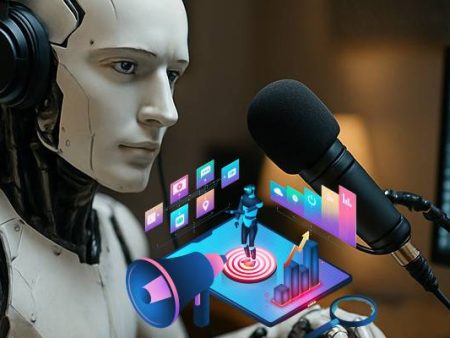Think about the last ad you heard online or on the radio. Maybe it was a friendly voice reminding you about a streaming subscription, or a soft, persuasive tone guiding you toward a new skincare product. Now, here’s the twist—was that voice real, or was it synthetic?
Artificial intelligence has crept into marketing faster than many of us realize. Today, AI-generated voices aren’t just narrating audiobooks or helping us navigate GPS systems.
They’re pitching products, using musicians tools sounds to craft jingles, tailoring ads to regions, and even mimicking the style of local celebrities.
This isn’t just clever marketing—it’s the beginning of a deeper ethical debate. Is AI-driven voice marketing about more natural voice personalization, making ads feel human and relevant? Or is it a subtle form of manipulation, designed to tug at emotional strings without us knowing?
This article unpacks the tech, the psychology, the opportunities, and the risks of AI voice in marketing, while asking the uncomfortable question: how much of this feels like a genuine innovation, and how much feels like crossing a line?
The Rise of AI Voices in Marketing
AI voice tech has gone from novelty to necessity in marketing. The numbers alone tell a compelling story:
- The global voice cloning market is projected to grow beyond $5 billion by 2032, driven largely by advertising and customer engagement (Precedence Research).
- By 2025, 70% of companies will use synthetic voice technologies in customer interactions, according to Gartner.
What’s driving this growth? Efficiency, scale, and personalization. A single AI voice can create thousands of ad variations in minutes.
Brands no longer need to hire dozens of narrators—they can generate synthetic regional accents, modify tone for different demographics, and adjust pacing depending on the platform.
The Battle Race for Authenticity
It’s no exaggeration to say there’s a battle race going on in the industry. Companies like ElevenLabs, Resemble AI, and Microsoft’s Azure AI are competing to develop voices indistinguishable from real humans.
This competition isn’t just about technical bragging rights. It’s about winning consumer trust. In marketing, the closer a voice feels to human authenticity, the more persuasive it becomes. But here’s the catch: the line between authenticity and deception is razor thin.
When a voice feels human but isn’t, does that build trust or erode it?
The Promise: Personalisation at Scale
AI voices open doors to levels of personalization that would have seemed impossible just a decade ago. Imagine:
- Dynamic ads: A travel company can generate thousands of audio ads in different accents, promoting flights tailored to specific cities.
- Brand consistency: A business can maintain the same voice across languages, regions, and campaigns, with subtle tweaks for cultural fit.
- Accessibility: AI voices can bring content to visually impaired audiences or customers who prefer audio over text.
For marketers, this is gold. It’s not just about efficiency—it’s about making the interaction feel relevant, intimate, even warm.
And let’s be honest, sometimes it works beautifully. I’ve heard AI-generated ads that sounded so natural, so polished, that I didn’t blink twice until I realized they were synthetic.
The Risk: Manipulation in Disguise
Now for the uncomfortable part. Personalization can easily slide into manipulation.
When a company fine-tunes a more natural voice to sound like someone from your community, it builds trust—but is that trust earned or engineered?
Here are the risks:
- Emotional exploitation: Voices can carry authority, warmth, or urgency. AI can exaggerate those cues to push people toward decisions they might not otherwise make.
- Consent issues: Celebrity or influencer voices can be cloned without approval, misleading audiences.
- Erosion of authenticity: When audiences realize the voices they trusted aren’t real, the backlash can be severe.
A Stanford University study showed that people are more likely to trust AI voices that mirror familiar human patterns, even when told the voice is synthetic. That trust, when manipulated, becomes a powerful psychological lever.
Case Studies: Success and Controversy
The Wins
- Coca-Cola experimented with AI-driven ad personalization, adjusting voice tone and style depending on regional campaigns. Customers in one market heard upbeat, youthful voices; another market heard calm, authoritative narrations.
- Spotify has tested synthetic voices for localized ads, reaching audiences in their own accents and dialects at scale.
These experiments show the upside: relevance and efficiency without necessarily crossing ethical lines.
The Missteps
- A deepfake Joe Rogan voice was used in an ad promoting a questionable supplement, causing outrage and raising legal concerns.
- In politics, AI-generated campaign robocalls mimicking leaders’ voices have already been banned by the FCC.
These cases underline how quickly trust can be eroded when AI voice marketing veers into deception.
The Sound of Music: Using Musicians Tools Sounds
It’s not just about speech. AI voices are colliding with music, creating ads that feature jingles “performed” by synthetic singers. Brands are using musicians tools sounds to generate melodies in familiar vocal styles, sometimes inspired by popular artists.
This is where it gets messy. While the creativity is exciting, it edges into murky legal ground when voices sound eerily like existing musicians. Listeners might not care in the moment, but the ethics of profiting from cloned artistry are thorny.
Synthetic Regional Voices: Belonging or Appropriation?
One of the most fascinating—and controversial—applications is synthetic regional voices. Companies can create localized voices that sound like they belong to a specific city or culture.
On the one hand, this feels inclusive. Imagine hearing an ad in a familiar local accent, instead of a generic national one. It feels personal, welcoming.
On the other hand, if no actual person from that community was involved, it veers toward appropriation. It risks reducing culture to an aesthetic layer for profit.
Regulation and Responsibility
Governments are starting to step in:
- The EU AI Act requires disclosure when synthetic voices are used in high-risk applications.
- The FCC has banned AI voices in robocalls to curb voter misinformation.
- Some states are expanding “right of publicity” laws to include voice cloning, protecting celebrities and individuals from unauthorized use.
But laws are always playing catch-up. Industry leaders need to adopt ethical guidelines before regulation forces their hand. Transparency—telling consumers when a voice is AI-generated—should be the bare minimum.
My Take: Walking the Tightrope
I find myself torn. Part of me is fascinated by the creative potential here. Imagine being able to hear an audiobook narrated in your favorite style, or an ad tailored not just to your needs but your community. Done right, this tech can feel magical.
But another part of me worries. When voices can be engineered to sound trustworthy, authoritative, or comforting on command, how do we safeguard free will? How do we ensure that personalization doesn’t become a tool for subtle coercion?
The line between helping and exploiting is thin. And while consumers might shrug today, over time, they may grow cynical, doubting every voice they hear. That erosion of trust could poison not just advertising but communication itself.
Conclusion: Finding Balance in the Noise
So, is AI voice in marketing about personalization or manipulation? The honest answer is: both.
It can be empowering when it makes ads relevant, inclusive, and accessible. But it can be harmful when it exploits emotion, clones voices without consent, or disguises intent.
As the battle race to perfect human-like voices continues, marketers, regulators, and audiences must ask tough questions. We need transparency, consent, and respect for cultural authenticity.
At its best, AI voice can enhance connection. At its worst, it undermines trust. The difference depends on how responsibly we choose to use the technology.


